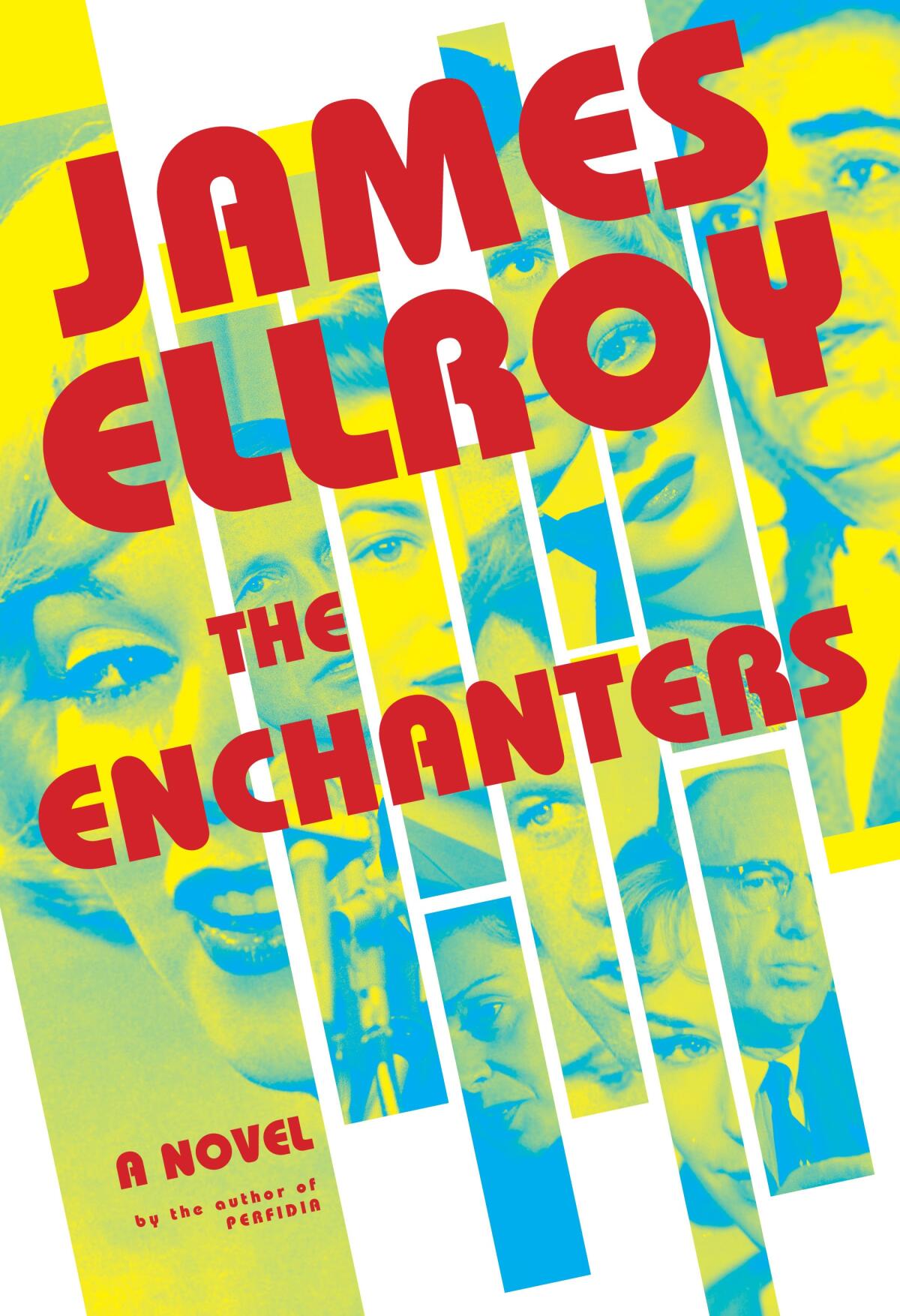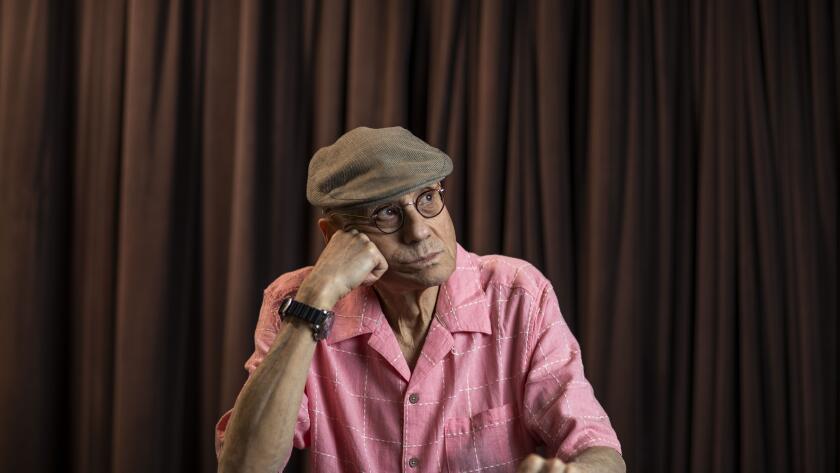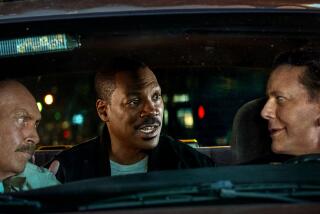James Ellroy has his way with 1960s L.A. — and the corpse of Marilyn Monroe
- Share via
In Ellroy’s book, a private detective plays the role of a Hollywood “fixer.”
- Share via
Review
The Enchanters
By James Ellroy
Knopf: 448 pages, $30
If you buy books linked on our site, The Times may earn a commission from Bookshop.org, whose fees support independent bookstores.
A little bit of James Ellroy can be a lot: the hepcat tough guy lingo, the contortionist plotting, the headfirst plummet into seedy sex, scandal and nihilism. His novels, mostly set in a bygone Los Angeles swirl of crime and corruption, can make you want to take a hot shower. But when he’s on, as he is in his new, Marilyn Monroe-centered book “The Enchanters,” a sort of fever takes hold of the reader.
Fact, fiction and conspiracy blur together until you can’t tell which is which, and you almost cease to care. The meticulous detail accumulates with a reportorial verve, each small action adding to the big picture. You start to see historical figures — be it Monroe, Bobby Kennedy or Ellroy’s antihero, a hopped-up mess of an off-the-books LAPD heavy named Freddy Otash — in a harsh new light. The experience might not be pleasant, but it is undoubtedly memorable.
James Ellroy goes full Ellroy in a conversation with Michael Connelly at the Festival of Books, riffing on the movie ‘L.A. Confidential’ and cancel culture.
This is Ellroy’s second novel to feature Otash, the real-life former police officer, private investigator and Hollywood fixer. It’s a vast improvement on the first, 2021’s “Widespread Panic,” which often drowned in a sudsy sea of awkward alliteration and seemed to get high on its own supply.
Make no mistake, Freddy O.’s supply remains formidable in “The Enchanters.” Indeed, it often reads like a performance enhancer: “My nerves decohered. I popped two yellow jackets to tamp them down and quash this schizzy limbo.” Or: “I dialed in, dialed out, stepped back and reframed. The dope hit me. It cocooned me, warm and safe. It resituated the shadows and magnified the candlelight.” (Kids: Do not try this at home.)

Freddy has a photographic memory, which he calls his “man camera,” and it often seems to work best under the influence. When it gets to be too much — “DT blobs grew faces and went for my eyes. I screamed and covered them” — he detoxes in the dark corners of a Chinese restaurant designed for such purposes. The food ain’t bad, either.
Freddy’s assignment this time around is, well, complicated. Dig it: Jimmy Hoffa assigns the fixer to get dirt on Monroe and the Kennedys, who are squeezing the Teamster head’s organized crime scene. Freddy starts his investigation. Then, Monroe is found dead. Bobby Kennedy, his brother John F. Kennedy’s attorney general at the time, wants to know what Freddy knows. So do LAPD Chief Bill Parker and his right hand and intelligence ace, a future chief by the name of Daryl Gates. Bobby the K doesn’t want evidence of his brother’s sexual promiscuity, especially among Hollywood starlets and hangers-on, to fall into the wrong hands. Parker wants to blackmail the attorney general into making him FBI chief.
The 13 most essential L.A. crime books — from Chandler, Hughes, Mosley and Ellroy to Steph Cha and Ivy Pochoda, with some ‘Helter Skelter’ in between.
Then there’s the episode that kicks off the novel, in which Freddy and the Hat Squad, a real-life quartet of elite and dangerous LAPD detectives, are called in to solve the kidnapping of a B-movie actress named Gwen Perloff. They end up dropping one suspect off a freeway overpass. Oops. The notorious 1963 20th Century Fox flop “Cleopatra” enters the picture as well.
As the sage Lester Freamon says on “The Wire,” all the pieces matter. It’s the job of Freddy, and the reader, to figure out how. Good luck. As in many Ellroy novels, the author continuously drops in little backtracking reminders of previously uncovered clues, rewinding our collective man camera, so to speak. Chances are you’ll still get lost, or feel compelled to construct one of those corkboards Freddy uses to keep track of the major players. Then again, Raymond Chandler himself is reported not to have known whether one death in his masterpiece, “The Big Sleep,” was a murder or a suicide. The point is that eventually, if the ride is thrilling enough, it doesn’t really matter.
It’s been a rough couple of years for Monroe, who died of a drug overdose in 1962. The 2022 film “Blonde” (based on Joyce Carol Oates’ novel), for which Ana de Armas’ performance as Monroe earned an Oscar nomination, put the actor through a series of torments and humiliations, including a rape at the hands of Fox chief Darryl F. Zanuck (which most research indicates never happened).
In “The Enchanters” she is depicted as a pill-popping, ditzy dilettante, deluded and drunk and self-centered and into some very shady stuff. All of which might have been true on some level, but “The Enchanters” exudes a sort of pervy and even necrophiliac delight in its postmortem. Here’s Freddy, sifting through evidence: “She was dead. I felt her and smelled her all over me.” Ick.
“Widespread Panic,” Ellroy’s latest novel, trades political intrigue for hardcore 1950s gossip via the confessions of real-life lowlife Fred Otash.
But this is what you get with Ellroy. The fever dream and the undiluted sleaze, in which he is far from the only crime novelist to indulge. Here, however, he’s messing with an icon (not to mention two popular political figures who met tragic deaths). The transgressions feel more severe, and, it must be said, more exciting. You might not want to live in Ellroy Land, but “The Enchanters” makes for a pretty wild visit.
Vognar is a freelance writer based in Houston.
More to Read
Sign up for our Book Club newsletter
Get the latest news, events and more from the Los Angeles Times Book Club, and help us get L.A. reading and talking.
You may occasionally receive promotional content from the Los Angeles Times.










